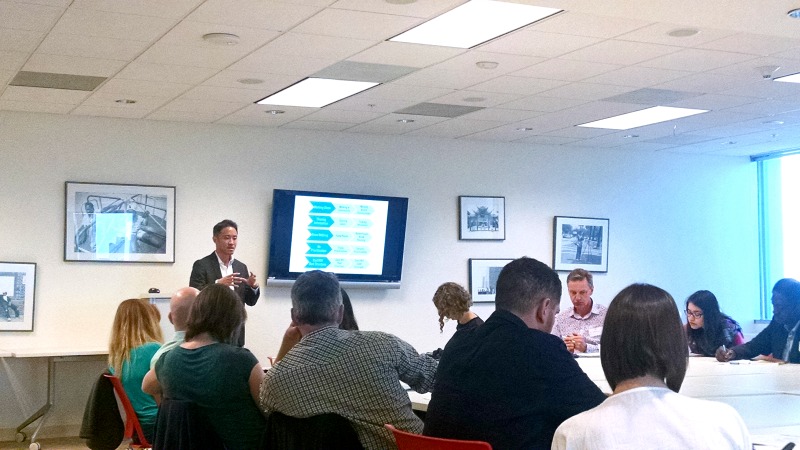Last June, we announced that our 100,000 Homes Campaign had helped communities find permanent homes for more than 105,000 of the most vulnerable Americans on our streets. But what if that milestone could help fuel a worldwide movement to end chronic homelessness?
This week in Los Angeles, the Building and Social Housing Foundation (BSHF) brought together changemakers from all over the world to learn about the 100,000 Homes Campaign with an eye toward mounting similar efforts in their home countries. Participants hailed from places as diverse as India, Ireland, France, South Africa and Chile. They came ready to learn from our successes and failures and to share their best ideas with one another. Over four days, the 100,000 Homes Campaign team from Community Solutions walked them through our approach to public leadership, data and performance management, communications, and current best practices in housing.
The learning exchange took place in conjunction with the 2013 World Habitat Award, which BSHF and the United Nations awarded last year to Community Solutions and the communities participating in the 100,000 Homes Campaign. A small delegation, including Shane Groen of the local Phoenix Campaign team and Rosanne Haggerty, president of Community Solutions, formally accepted the award in Medellín, Colombia earlier this year.
Day one of the exchange saw presentations from each of the 16 international participants about their work to end homelessness in their home countries. The learning continued as Senior Improvement Advisor Leslie Wise and local outreach worker Richard Meyers led attendees on a walking tour of Skid Row in downtown Los Angeles. Skid Row is a 50-square block area lined with tents belonging to the more than 3,500 people who experience homelessness there on any given night. The visual sight can be jarring, especially for international visitors who often do not expect to see such poverty in the United States. One attendee confessed that she had taken a “star tour” of the city’s opulent celebrity mansions the previous day and wondered aloud how such wealth and such destitution could exist in the same place.
In 2013, Community Solutions began working with the Rapid Results Institute and Home For Good, Los Angeles’ countywide effort to end chronic and veteran homelessness, to develop a coordinated approach to ending homelessness on Skid Row. Together with local frontline workers, we helped to streamline the local housing process, build technology to track vacant apartments and people who needed housing, and develop a new workflow to help various agencies and organizations on the ground work together more efficiently. Today, people experiencing homelessness on Skid Row have their needs assessed the same way and are connected to appropriate and available housing options through the same user-friendly database. The result is an efficient, coordinated, evidence-based system that is already helping many Skid Row service providers find housing for their most vulnerable clients.
Day two of the exchange offered a deep dive into the Campaign’s data and organizing practices. Paul Howard, Senior Director of Knowledge Sharing at Community Solutions, led participants through a detailed discussion of the differences between real-time data for performance improvement and more traditional approaches that privilege infrequent data collection for grant reporting and other secondary purposes. Rather than simply tracking the number of people experiencing homelessness in their communities each year, communities that participated in the Campaign embraced monthly housing targets aimed at putting them measurably on track to end chronic and veteran homelessness in a clear timeframe. This led to the creation of the Campaign’s elite 2.5 Percent Club, a group of on-track communities that grew from 12 to 60 over time.
Jake Maguire, Director of Communications at Community Solutions, also conducted a session on the Campaign’s approach to communications, which emphasized media and storytelling as central aspects of the work to end homelessness. Traditionally, in the nonprofit sector, these tools have been viewed largely as support functions to boost fundraising and enlist new supporters. The Campaign team viewed changing the narrative around homelessness as a central piece of ending it and invested time and treasure in helping people embrace a new story about what is possible. Maguire also discussed the challenges of communicating within a national movement made up of hundreds of independent stakeholders and shared some of the Campaign team’s key learnings around how to share credit effectively.
“The more communities felt recognized and a part of something,” Maguire said, “the more energized they became to do the hard work of changing their local systems and adopting a new way of working together.”
On day three, attendees visited with the Conrad N. Hilton Foundation for a funder perspective on the Campaign and its approach. They also took part in a series of site visits in the San Fernando Valley, including a trip to a permanent supportive housing building that now houses many of those previously identified as the most vulnerable people experiencing homelessness in that area. Through conversations with the local coalition of organizations and agencies that led the Campaign in the Valley, participants got a clearer sense of the way communities collaborated on the ground, especially around breaking down existing silos of work and building more cohesive local systems.
On the final day of the visit, Community Solutions staff presented exchange participants with a series of key decisions that the Campaign team had confronted over the last four years and asked them to break into groups to workshop their own approaches and strategies. Each group presented on its scenario and reviewed its proposed strategy for moving forward before engaging in Q+A with the room. At the conclusion of the exercise, Community Solutions staff revealed how they had actually handled each key decision and what the results had been. The exercise proved to be a powerful exchange of learning and new ideas.
Attendees will now put those ideas to use as they return to their home countries to weigh campaign-style efforts of their own. Asked to share their key takeaways in the final session of the visit, participants offered a hopeful range of plans and commitments. One woman expressed a sense of urgency around implementing monthly performance data throughout her organization, which runs housing programs in 19 sites throughout South America. Another participant discussed plans to apply the Campaign’s learnings to a promising new effort to help hospitals prevent homelessness among patients with mental illness.
In the final minutes of the exchange, Kat Johnson, Executive Director of the recently launched Institute of Global Homelessness, summed up the group’s sentiments concisely.
“I arrived feeling uncertain about whether the Campaign’s learnings would be useful to such a diverse group of people from such distinct development contexts,” said Johnson. “It has become clear to me that there is so much commonality. There is a real need for internationally rooted insights into homelessness and how to end it.”




